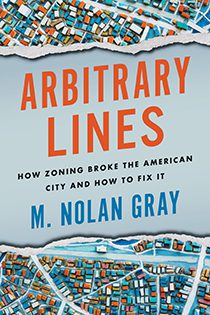‘Arbitrary Lines’ and the case for killing zoning

You’ve surely seen them, but you might not have noticed them—roadside signs with a big “Z,” indicating an upcoming public hearing on zoning at an interminable City Council meeting. Most of us know that zoning exists. Perhaps we even know it involves planning and land use. But for many of us, the specific details are a little vague. We just know that zoning is one of those things that’s a necessary feature of modern cities.
Not so fast, cautions M. Nolan Gray, a planner-turned-scholar and author of the new book Arbitrary Lines: How Zoning Broke the American City and How to Fix It. Zoning, Gray insists, has been an abject failure for the roughly 100 years it has been used in American cities.
Zoning has failed to achieve its basic aims while producing many negative consequences (some unintended, but others very much so). Gray does not mince words: “abolishing zoning is a necessary—if not sufficient—change if we want to build a more affordable, prosperous, equitable, and sustainable American city.”
|
|
The book is written for a general audience. It’s a quick, accessible, and engaging read. Most readers will learn something, and many will be persuaded by Gray’s forceful arguments. I heartily recommend it to anyone affected by zoning—which is really everyone.
The book is organized into three parts. The first part is a primer on zoning. At its core, zoning describes a set of rules and regulations adopted by local governments to restrict what landowners can do with their private property. Most notably, zoning restricts how property owners can use their land and limits the density to which they can develop their land.
Additionally, zoning regulates the “envelope” in which a landowner can construct a building and establishes rules like minimum lot sizes and minimum parking requirements. The stated goal of zoning was to bring order to the chaotic processes of urban growth.
Zoning was proposed as a means of preventing incompatible uses (say, a slaughterhouse next to an elementary school) and to ensure that dense development occurred only where it could be supported by adequate infrastructure and public services.
But Gray summarizes research suggesting that the true intentions behind zoning were not so high-minded. Rather, zoning was adopted by urban elites—with the encouragement of the federal government—as “a mechanism of exclusion designed to inflate property values, slow the pace of new development, segregate cities by race and class, and enshrine the detached single-family house as the exclusive urban ideal.”
In part two, Gray analyzes some of the major effects of zoning, including zoning’s key role in creating the country’s current housing-affordability crisis. Zoning restricts the number of housing units that can be built. In cities with growing demand for housing consumption (whether because of growing population or growing wealth), this means that housing supply will fail to keep up, which means prices will rise.
Most American cities’ zoning severely restricts more affordable housing options like apartments, and bans outright the most affordable housing options like single-room occupancies and manufactured housing, which were once plentiful.
In addition, Gray details economic research showing that restrictive zoning has cost the nation trillions (with a “t”!) of dollars by driving workers from the most productive, innovative—and expensive—cities. Zoning also perpetuates patterns of racial and economic segregation caused by the past’s discrimination. In this respect, Gray notes bitterly, zoning has been “remarkably successful” in achieving its original goals.
Finally, Gray explains that zoning is built upon an assumption everyone owns a car, mandating a sprawling pattern of regional design for all residents and denying choice to those who might want to live in more compact, walkable, and thus environmentally sustainable communities.
In part three, Gray sets out his recommendations for reform.
- He identifies several reforms that would make zoning “less bad,” including eliminating single-family-housing-only zoning districts (as Charlotte is poised to do in its new Unified Development Ordinance), minimum parking requirements, minimum floor areas and lot sizes, and bans on the most affordable types of housing.
- He recommends states rein in local governments’ ability to use restrictive zoning to create exclusive, affluent communities.
- And he expresses admiration for Japan’s simpler system, in which the national government has established twelve districts, each of which is more accommodating that most U.S. zoning districts (none of the Japanese districts has single-family-only zoning, whereas over 75% of most U.S. cities are zoned as such).
Ultimately, though, Gray views zoning as unworthy of saving.
“We can’t tinker our way out of this one,” he writes, “the longer-term objective must be zoning abolition.”
He does not dispute the importance of separating incompatible uses or thoughtfully planning for future infrastructure and services needs. But zoning fails to achieve either of those goals, Gray argues, and there are alternative tools that work at least as well—without zoning’s negative side effects.
[Lessons from ‘Fixer-Upper: How to Repair America’s Broken Housing Systems’]
In a chapter likely to elicit some raised eyebrows (or perhaps even eye rolls), Gray extols the virtues of Houston, the “great unzoned city.” To be clear, Gray does not offer up Houston as an urban utopia. Rather, he argues that Houston is proof that a city can function—and even thrive—without zoning. Houston has a huge, dynamic economy. It’s the most diverse city in the country. And without zoning, Houston’s housing supply has been able to match demand, keeping prices affordable.
Why didn’t Houston adopt zoning? Gray credits a political compromise—an analysis that will strike you as pragmatic or cynical, depending on your perspective. Residents of Houston’s affluent neighborhoods desired the same sorts of restrictive policies as their counterparts in other American cities, according to Gray’s account.
But the rest of the city was able to essentially buy them off and prevent the adoption of citywide zoning by granting them the ability to accomplish their goals via private deed restrictions. Thus, these Houston neighborhoods look and function much like the exclusive, restrictive neighborhoods Gray spends much of the book criticizing. But he nevertheless prefers Houston because the scope of the restrictions is much narrower, permitting more development elsewhere.Gray is comfortable enough with the compromise that he suggests it as a path forward in other cities, to make the abolition of zoning more palatable to more voters.
Gray concludes the book with a call for a reinvigorated planning profession that does more of what historical city planners did—lay out street networks and plan for public parks and other infrastructure. Planners should focus more on actual incompatible and disruptive actions rather than the vague, over- and under-inclusive use categories that dominate zoning. And they should imagine ways to make cities more vibrant and inclusive places.
There’s a lot of work to do, Gray says, but the first step is to abolish zoning—along with those “Z” roadside signs and interminable City Council meetings.
[Editor’s note: The Urban Institute’s new Director of Regional Policy, Dr. Aaron Houck, reviews books about policy questions relevant to the Charlotte region from time to time. If you have comments or suggestions, you can reach him at aaron.houck@charlotte.edu]
